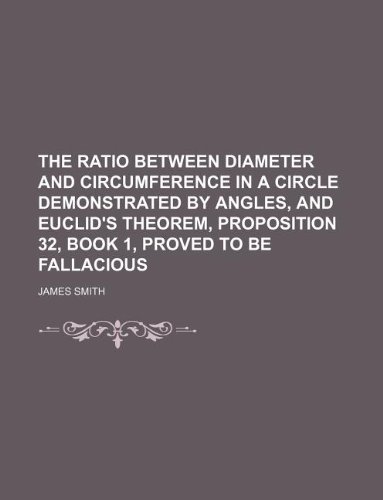-
The ratio between diameter and circumference in a circle demonstrated by angles, and Euclid's theorem, proposition 32, book 1, proved to be fallacious
James Smith
Paperback (RareBooksClub.com, March 6, 2012)This historic book may have numerous typos and missing text. Purchasers can download a free scanned copy of the original book (without typos) from the publisher. Not indexed. Not illustrated. 1870 Excerpt: ...will be equal to four right angles. In either case the angles at the centre of the circle will be equal to the arcs by which they are subtended. Hence: Euclid's 19th definition is positively fallacious. J. Radford Young, a living "recognised Mathematician" saw this, for, in his "Elements of Euclid" he observes:--" The term polygon, however, is often employed as a general name for rectilineal figures of all kinds, without regard to the number of sides; so that the rectilineal figures defined above (definitions XVII. and XVIII.), may, without impropriety, be called polygons of three and of four sides respectively." This brings to light some remarkable facts, with reference to Mathematics as applied to Geometry. If a regular polygon of any number of sides greater than 4 be inscribed in a circle, the ratio between the sides of the polygon and their subtending arcs is constant, and-expresses this ratio, whatever be the value of It; but this ratio does not hold good for a polygon of 3 or of 4 sides inscribed in a circle. But, if the circumference of a circle be divided into any number of equal arcs, and from one of these arcs T'sth part be deducted, and the remainder be multiplied by the sum of the arcs, the product is constant, and equal to the perimeter of a regular hexagon or six-sided polygon inscribed in the circle: and this is true, whether the inscribed polygon to the circle, be a polygon of 3 sides or of 4 sides, or of any other number of sides. Any one conversant with the simple rules of arithmetic "can follow out and test this." Geometry is an exact science, and Geometers by excluding arithmetical considerations from their study of Geometry, are led into all sorts of blunders; and I am glad to find, that "rec...
-
The Ratio Between Diameter and Circumference in a Circle Demonstrated by Angles, and Euclid'S Theorem, Proposition 32, Book 1, Proved to Be Fallacious
James Smith
Paperback (Nabu Press, Jan. 1, 2010)This is a reproduction of a book published before 1923. This book may have occasional imperfections such as missing or blurred pages, poor pictures, errant marks, etc. that were either part of the original artifact, or were introduced by the scanning process. We believe this work is culturally important, and despite the imperfections, have elected to bring it back into print as part of our continuing commitment to the preservation of printed works worldwide. We appreciate your understanding of the imperfections in the preservation process, and hope you enjoy this valuable book.
-
The Ratio Between Diameter and Circumference in a Circle Demonstrated by Angles, and Euclid's Theorem, Proposition 32, Book 1, Proved to Be Fallacious
Colonel James Smith
Hardcover (Palala Press, May 18, 2016)This work has been selected by scholars as being culturally important, and is part of the knowledge base of civilization as we know it. This work was reproduced from the original artifact, and remains as true to the original work as possible. Therefore, you will see the original copyright references, library stamps (as most of these works have been housed in our most important libraries around the world), and other notations in the work.This work is in the public domain in the United States of America, and possibly other nations. Within the United States, you may freely copy and distribute this work, as no entity (individual or corporate) has a copyright on the body of the work.As a reproduction of a historical artifact, this work may contain missing or blurred pages, poor pictures, errant marks, etc. Scholars believe, and we concur, that this work is important enough to be preserved, reproduced, and made generally available to the public. We appreciate your support of the preservation process, and thank you for being an important part of keeping this knowledge alive and relevant.
-
The Ratio Between Diameter and Circumference in a Circle Demonstrated by Angles, and Euclid'S Theorem, Proposition 32, Book 1, Proved to Be Fallacious
James Smith
Paperback (Ulan Press, Aug. 31, 2012)This book was originally published prior to 1923, and represents a reproduction of an important historical work, maintaining the same format as the original work. While some publishers have opted to apply OCR (optical character recognition) technology to the process, we believe this leads to sub-optimal results (frequent typographical errors, strange characters and confusing formatting) and does not adequately preserve the historical character of the original artifact. We believe this work is culturally important in its original archival form. While we strive to adequately clean and digitally enhance the original work, there are occasionally instances where imperfections such as blurred or missing pages, poor pictures or errant marks may have been introduced due to either the quality of the original work or the scanning process itself. Despite these occasional imperfections, we have brought it back into print as part of our ongoing global book preservation commitment, providing customers with access to the best possible historical reprints. We appreciate your understanding of these occasional imperfections, and sincerely hope you enjoy seeing the book in a format as close as possible to that intended by the original publisher.